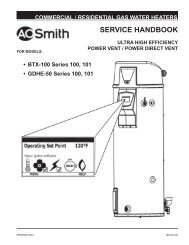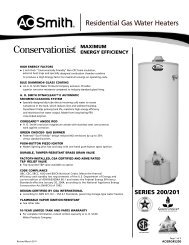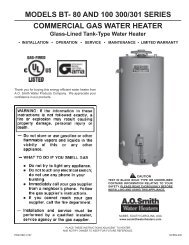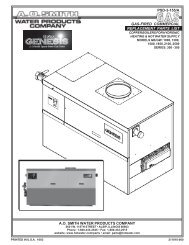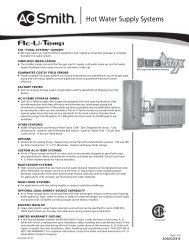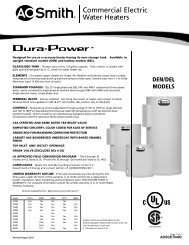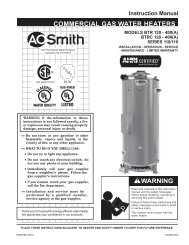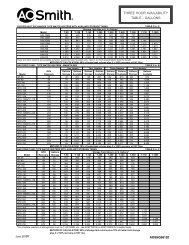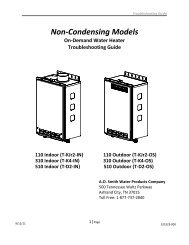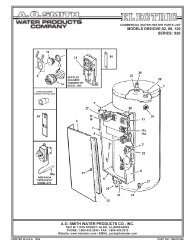185171-001 - A.O. Smith Water Heaters
185171-001 - A.O. Smith Water Heaters
185171-001 - A.O. Smith Water Heaters
You also want an ePaper? Increase the reach of your titles
YUMPU automatically turns print PDFs into web optimized ePapers that Google loves.
RESIDENTIALGAS WATER HEATERSOWNER'S MANUALThank you for buying this energy efficient water heater fromA.O. <strong>Smith</strong> <strong>Water</strong> Products Company. We appreciate yourconfidence in our products.You should thoroughly read this manual before installationand/or operation of this water heater. Please pay particularattention to the important safety and operating instructions aswell as the WARNINGS and CAUTIONS.Power Vented Gas ModelsGPSH/GPCRwith Hot Surface IgnitionTABLE OF CONTENTSPAGEGET TO KNOW YOUR WATER HEATER 2GENERAL SAFETY INFORMATION 3INSTALLATION 4-12OPERATION & LIGHTING INSTRUCTIONS 12-15MAINTENANCE 15-16TROUBLESHOOTING 17-18WARRANTY 19CAUTIONTEXT PRINTED OR OUTLINED IN RED CONTAINSINFORMATION RELATIVE TO YOUR SAFETY. PLEASE READTHOROUGHLY BEFORE INSTALLING AND USING THISAPPLIANCE.A DIVISION OF A.O. SMITH CORPORATIONMCBEE, SOUTH CAROLINAwww.hotwater.comKEEP THIS MANUAL IN THE POCKET ON THE HEATER FOR FUTURE REFERENCEWHENEVER MAINTENANCE ADJUSTMENT OR SERVICE IS REQUIRED.PRINTED IN U.S.A. 0605 PART NO. <strong>185171</strong>-<strong>001</strong>1
GET TO KNOW YOUR WATER HEATERREPLACEMENT PARTS AND DELIMING PRODUCTSReplacement parts and recommended delimer may be orderedthrough authorized servicers or distributors. Refer to the YellowPages for where to call. When ordering parts, provide completemodel and serial numbers (see rating plate), quantity and nameof part desired (as listed in Figure 1). Standard hardware itemsmay be purchased locally.(A) Vent Pipe - Exhaust(B) Vent Terminal(C) Vent Adapter-Rubber Boot(D) Blower Assembly(E) Cold <strong>Water</strong> Inlet(F) Inlet <strong>Water</strong> Shut-off Valve(G) Union(H) Inlet Dip Tube(J) Anode**(K) Hot <strong>Water</strong> Outlet(L) Oulet Receptacle (115 VAC)(M) Temperature-PressureRelief Valve(N) Flue(O) Flue Baffle Assembly**(P) Insulation(Q) Control Harness(R) Rating Plate(S) Gas Supply(T) Manual Gas Shut-off Valve(U) Ground Joint Union(V) Dirt Leg (Sediment Trap)(W) Drain Valve(X) Gas Valve - Thermostat(Y) Drain Pan(Z) Inner Door(AA) Outer Door(BB) HSI Burner Assembly**Located Under Blower AssemblyNATURAL HOT SURFACE IGNITER & MAIN BURNERHOTSURFACEIGNITORSENSORPROPANE HOT SURFACE IGNITER & MAIN BURNERHOTSURFACEIGNITORSENSOR*CAUTION: 115VAC IN CONTROL HARNESSAND INSIDE OUTER DOORTEMPERATURE INDICATORSGAS MODELSWITH HOT SURFACE IGNITION& - 2" OR 3" PVC VENT CAPABILITYTEMPERATURE ADJUSTMENT BUTTONSFIGURE 12
GENERAL SAFETY INFORMATIONEXTERNAL DAMAGEDo not operate the water heater until it has been fully checkedout by a qualified technician, if the water heater:• Has been exposed to fire or damage.• Displays evidence of sooting.• Produces steam or unusually hot water.If the water heater has been flooded it must be replaced.CHEMICAL VAPOR CORROSIONWARNINGCORROSION OF THE FLUEWAYS AND VENT SYSTEM MAYOCCUR IF AIR FOR COMBUSTION CONTAINS CERTAINCHEMICAL VAPORS. SUCH CORROSION MAY RESULT INFAILURE AND RISK OF ASPHYXIATION.Spray can propellants, cleaning solvents, refrigerator and airconditioning refrigerants, swimming pool chemicals, calcium andsodium chloride (water softener salt), waxes, and processchemicals are typical compounds which are potentially corrosive.Do not store products of this sort near the heater. Also, air whichis brought in contact with the heater should not contain any ofthese chemicals. If necessary, uncontaminated air should beobtained from remote or outside sources. The limited warranty isvoided when failure of water heater is due to a corrosiveatmosphere. (Reference is made to the limited warranty forcomplete terms and conditions).IMPROPER COMBUSTIONWARNINGATTIC AND/OR EXHAUST FANS OPERATING ON THEPREMISES WITH A WATER HEATER CAN RESULT IN CARBONMONOXIDE POISONING AND DEATH.OPERATION OF THESE FANS CAN PRODUCE A NEGATIVEDRAFT IN THE AREA OF THE WATER HEATER PREVENTINGTHE PRODUCTS OF COMBUSTION FROM EXHAUSTINGTHROUGH THE VENT PIPE.The venting of the water heater should be inspected by a qualifiedservice technician at the time of installation and periodicallythereafter to ensure a down-draft condition does not exist.DO NOT OBSTRUCT THE FLOW OF COMBUSTION ANDVENTILATING AIR. ADEQUATE AIR FOR COMBUSTION ANDVENTILATION MUST BE PROVIDED FOR SAFE OPERATION.LIQUID PETROLEUM MODELSWARNING<strong>Water</strong> heaters for propane or liquefied petroleum gas (LPG) aredifferent from natural gas models. A natural gas heater will notfunction safely on LP gas and no attempt should be made toconvert a heater from natural gas to LP gas.then call your gas supplier or service agent. Keep area clearuntil a service call has been made.At times you may not be able to smell an LP gas leak. One causeis odor fade, which is a loss of the chemical odorant that gives LPgas its distinctive smell. Another cause can be your physicalcondition, such as having a cold or a diminishing sense of smellwith age. For these reasons, the use of a propane gas detectoris recommended.IF YOU EXPERIENCE AN OUT-OF-GAS SITUATION, DO NOTTRY TO RELIGHT APPLIANCE YOURSELF. Ask your LP deliveryperson to relight pilots for you. Only trained LP professionalsshould conduct the required safety checks in accordance withindustry standards.EXTENDED NON-USE PERIODSWARNINGHYDROGEN GAS CAN BE PRODUCED IN A HOT WATERSYSTEM SERVED BY THIS HEATER THAT HAS NOT BEENUSED FOR A LONG PERIOD OF TIME (GENERALLY TWOWEEKS OR MORE). HYDROGEN GAS IS EXTREMELYFLAMMABLE. To reduce the risk of injury under these conditions,it is recommended that the hot water faucet be opened for severalminutes at the kitchen sink before using any electrical applianceconnected to the hot water system. If hydrogen is present, therewill probably be an unusual sound such as air escaping throughthe pipe as the water begins to flow. THERE SHOULD BE NOSMOKING OR OPEN FLAME NEAR THE FAUCET AT THE TIMEIT IS OPEN.INSULATION BLANKETSInsulation blankets available to the general public for externaluse on gas water heaters are not approved for use on yourwater heater. The purpose of an insulation blanket is to reducethe standby heat loss encountered with storage tank heaters.Your water heater meets and exceeds the National ApplianceEnergy Conservation Act standards with respect to insulationand standby loss requirements, making an insulation blanketunnecessary.WARNINGShould you choose to apply an insulation blanket to this heater,you should follow these instructions (See Figure 1 foridentification of components mentioned below). Failure to followthese instructions can restrict the air flow required for propercombustion, potentially resulting in fire, asphyxiation, seriouspersonal injury or death.• Do not cover the outer door, thermostat or temperature &pressure relief valve.• Do not allow insulation to come within 2 inches of dilution airinlet on the blower to prevent blockage of the dilution air.• Do not allow insulation to come within 2" of the floor to preventblockage of combustion air flow to the burner.• Do not cover the instruction manual. Keep it on the side ofthe water heater or nearby for future reference.LP gas must be used with great caution. It is highly explosiveand heavier than air. It collects first in the low areas making itsodor difficult to detect at nose level. If LP gas is present or evensuspected, do not attempt to find the cause yourself. Go to aneighbor's house, leaving your doors open to ventilate the house,3• Do obtain new warning and instruction labels for placementon the blanket directly over the existing labels.• Do inspect the insulation blanket frequently to make certain itdoes not sag, thereby obstructing combustion air flow.
INSTALLATIONREQUIRED ABILITYINSTALLATION OR SERVICE OF THIS WATER HEATERREQUIRES ABILITY EQUIVALENT TO THAT OF A LICENSEDTRADESMAN IN THE FIELD INVOLVED. PLUMBING, AIRSUPPLY, VENTING AND GAS SUPPLY ARE REQUIRED.GENERALThe installation must conform to these instructions and the localcode authority having jurisdiction. In the absence of local codes,the installation must comply with the current editions of theNational Fuel Gas Code ANSI Z223.1/NFPA 54 and the NationalElectrical Code, NFPA 70. The former is available from theCanadian Standards Association, 8501 East Pleasant ValleyRoad, Cleveland, OH 44131, and both documents are availablefrom the National Fire Protection Association, 1 BatterymarchPark, Quincy, MA 02269.GROUNDINGThe water heater when installed must be grounded inaccordance with local codes, or in the absence of local codes:In the United StatesThe National Electric Code, ANSI/NFPA 70.AIR REQUIREMENTSDilution air temperature must be 100°F or less. In calculating thefree area of a vent opening, the blocking effect of screens, louversand grills should be considered. Screens shall not be of a meshsmaller than 1/4 inch square. If the free area is not known, thecurrent edition of National Fuel Gas Code ANSI Z223.1/NFPA 54recommends using figures of 20-25 percent free area for woodlouvers or 60-75 percent for metal grills or louvers.UNCONFINED SPACEIn buildings of conventional frame, brick or stone construction,unconfined spaces may provide adequate air for combustion,ventilation, and dilution air for power venter.If the unconfined space is within a building of tight construction(as defined in the most recent revision of the National Fuel GasCode Handbook), air for combustion, ventilation, and venterdilution must be obtained from outdoors. The installationinstructions for confined spaces must be followed.HIGH ALTITUDE INSTALLATIONWARNINGSTANDARD MODELS ARE FOR INSTALLATION UP TO 2,000FEET (610m) ABOVE SEA LEVEL.IF A STANDARD MODEL IS INSTALLED ABOVE 2,000 FEET(610m), INPUT RATING SHOULD BE REDUCED AT A RATE 4PERCENT FOR EACH 1,000 FEET (305m) ABOVE SEA LEVELWHICH REQUIRES REPLACEMENT OF THE BURNER ORIFICEIN ACCORDANCE WITH THE NATIONAL FUEL GAS CODE(ANSI Z223.1/NFPA 54).FAILURE TO REPLACE THE STANDARD ORIFICE WITH A HIGHALTITUDE ORIFICE WHEN INSTALLED ABOVE 2,000 FEET(610m) COULD RESULT IN IMPROPER AND INEFFICIENTOPERATION OF THE WATER HEATER, PRODUCING CARBONMONOXIDE GAS IN EXCESS OF SAFE LIMITS, WHICH COULDRESULT IN SERIOUS INJURY OR DEATH. CONTACT YOURLOCAL GAS SUPPLIER FOR ANY SPECIFIC CHANGES WHICHMAY BE REQUIRED IN YOUR AREA.LOCATION OF HEATERThe heater is design certified by the Canadian StandardsAssociation for installation on combustible flooring in a closethaving minimum clearances from combustible material of: 0"clearance from sides and rear, 5" from the front and 12" from thetop. (Standard clearance.) If clearances stated on the heaterdiffer from standard clearances, install water heater accordingto clearances stated on heater.Adequate clearance for servicing this appliance should beconsidered before installation, such as changing the anodes, etc.A minimum clearance of 5" must be allowed for access toreplaceable parts such as the thermostats, drain valve and reliefvalve.When installing the heater, consideration must be given to properlocation. Location selected should be as close to the wall aspracticable and as centralized with the water piping system aspossible.CONFINED SPACEWhen drawing combustion and dilution air from inside aconventionally constructed building to a confined space, such aspace shall be provided with two permanent openings; ONEWITHIN 12 INCHES OF THE ENCLOSURE TOP AND ONEWITHIN 12 INCHES OF THE ENCLOSURE BOTTOM. Eachopening shall have a free area of one square inch per 1000 Btuhof the total input of all appliances in the enclosure, but not lessthan 100 square inches.If the confined space is within a building of tight construction, airfor combustion, ventilation and power venter dilution must beobtained from outdoors. When directly communicating with theoutdoors or communicating through vertical ducts, twopermanent openings, located in the above manner, shall beprovided. Each opening shall have a free area of not less thanone square inch per 4000 Btuh of the total input of all appliancesin the enclosure. If horizontal ducts are used, each openingshall have a free area of not less than one square inch per 2000Btuh of the total input of all appliances in the enclosure.4Installation:Do not install water heaterwhere flammable productswill be stored or usedunless the main burner andhot surface igniter are atleast 18” above the floor.This will reduce, but noteliminate, the risk of vaporsbeing ignited by the mainburner or hot surfaceigniter.
To prevent damage, care must be taken not to apply too muchtorque when attaching gas supply pipe to gas valve inlet. Thethermostat inlet has a pad for use with back up wrench.Apply joint compounds (pipe dope) sparingly and only to themale threads of pipe joints. Do not apply compound to the firsttwo threads. Use compounds resistant to the action of liquefiedpetroleum gases. Do not use teflon tape on gas valve fittings.DISCONNECT THE APPLIANCE AND ITS INDIVIDUAL SHUTOFF VALVE FROM THE GAS SUPPLY PIPING SYSTEMDURING ANY SUPPLY PRESSURE TESTING EXCEEDING1/2 PSI (3.5 kPa). GAS SUPPLY LINE MUST BE CAPPEDWHEN DISCONNECTED FROM THE HEATER. FOR TESTPRESSURES AT 1/2 PSI (3.5 kPa) OR LESS, THE APPLIANCENEED NOT BE DISCONNECTED, BUT MUST BE ISOLATEDFROM THE SUPPLY PRESSURE TEST BY CLOSING THE MAINMANUAL GAS VALVE.IMPORTANTThe vent system must terminate so that proper clearances aremaintained as cited in local codes or the current edition of theNational Fuel Gas Code, ANSI Z223.1/NFPA 54, 7.3.4e and 7.8a,b,as follows:1. The exit terminals of a mechanical vent system shall be notless than 7 feet above grade when located adjacent to publicwalkways. (Figure. 3)2. A venting system shall terminate at least 3 feet above anyforced air inlet located within 10 feet. (Figure 3)3. The venting system shall terminate at least 4 feet below, 4feet horizontally from or, 1 foot above any door, window orgravity air inlet into any building.The manufacturer also recommends that the vent terminationshould not be installed closer than 3 feet from an insidecorner of an L shaped structure and not be less than 1 footabove grade.BEFORE PLACING THE HEATER IN OPERATION, CHECK FORGAS LEAKAGE. USE SOAP AND WATER SOLUTION OR OTHERMATERIAL ACCEPTABLE FOR THIS PURPOSE. DO NOT USEMATCHES, CANDLES, FLAME OR OTHER SOURCES OFIGNITION TO LOCATE GAS LEAKS.RELIEF VALVE (P)-FIG. 1A NEW TEMPERATURE AND PRESSURE RELIEF VALVECOMPLYING WITH THE STANDARD FOR RELIEF VALVES ANDAUTOMATIC GAS SHUT OFF DEVICES FOR HOT WATERSUPPLY SYSTEMS, ANSI Z21.22 (CURRENT EDITION) MUSTBE INSTALLED IN THE HEATER IN THE MARKED OPENINGPROVIDED. THE VALVE MUST BE OF A SIZE (INPUT RATING)THAT WILL BE ADEQUATE FOR YOUR SIZE HEATER.Check the metal tag on the relief valve and compare it to theheater’s rating plate. The pressure rating of relief valve must notexceed the working pressure shown on the rating plate of theheater. In addition the hourly Btu rated temperature steamdischarge capacity of the relief valve shall not be less than theinput rating of the heater. NO VALVE IS TO BE PLACED BETWEENTHE RELIEF VALVE AND TANK. DO NOT PLUG THE RELIEFVALVE.The drain line connected to this valve must not contain a reducingcoupling or other restriction and must terminate near a suitabledrain to prevent water damage during valve operation. Thedischarge line shall be installed in a manner to allow completedrainage of both the valve and line. DO NOT THREAD, PLUGOR CAP THE END OF THE DRAIN LINE.VENTINGWARNINGNEVER OPERATE THE HEATER UNLESS IT IS VENTED TOTHE OUTDOORS AND HAS ADEQUATE AIR SUPPLY TO AVOIDRISKS OF IMPROPER OPERATION, FIRE, EXPLOSION ORASPHYXIATION.Make sure the flue baffle and flue restrictor ring are properlyaligned and inserted on top of the flue. This can be checkedthrough the dilution air inlet of the blower.NOTE:VENT PIPE TERMINATIONBefore installing power venter determine place of ventpipe termination. See figure 3 on page 7.6The vent shall terminate a minimum of 12'' above expectedsnowfall level to prevent blockage of vent termination.4. In cold climates, it is recommended that vent termination notbe mounted directly above or within 3 feet horizontally from anoil tank vent or gas meter to avoid potential freeze-up fromcondensation.Plan the vent system layout so that proper clearances aremaintained from plumbing and wiring.Vent pipes serving power vented appliances are classified bybuilding codes as “vent connectors”. Required clearances fromcombustible materials must be provided in accordance withinformation in this manual under LOCATION OF HEATER andVENT TERMINAL INSTALLATIONS, and with the National FuelGas Code and local codes.IMPORTANTPlan the layout of the vent system from the vent termination to theappliance considering all of the 90 degree and 45 degree elbowsplus the number of feet of pipe that would be needed to install thetotal vent system. Make sure to include the 90 degree elbow ifrequired at the blower. Review the tables on page 9 to make surethat the vent system is within the allowed vent configuration. Multiplefittings, 90 or 45 degree, installed in close proximity to each othercould result in intermittent lockouts or prevent the unit from firing.Plan the layout to locate the fittings as far apart as possible.CAUTIONTermination of the vent system with a device other than the 2",22.50 degree schedule 40 elbow (supplied with the unit) or a 3",45 degree schedule 40 elbow (supplied locally) could affect thesystem performance and result in a safety hazard. If the 3" elbowis used for the vent terminal, then the screens (supplied withthis unit) for those elbows must be used and installed accordingto the provided instructions.VENT TERMINAL INSTALLATION1. After the point of termination has been determined, use thecover plate as a template to mark the hole for the vent pipe toinsert through the wall. BEWARE OF CONCEALED WIRINGAND PIPING INSIDE OF WALL.2. If the Vent Terminal is being installed on the outside of afinished wall, it may be easier to mark both the inside andoutside wall. Align the holes by drilling a hole through thecenter of the template from the inside through to the outside.The template can now be positioned on the outside wall usingthe drilled hole as a centering point for the template.
WARNINGVENT HOOD(S) MAY BEEXTREMELY HOT DURINGOPERATIONFIGURE 33. A) MASONRY SIDE WALLSChisel an opening approximately one half inch larger than themarked circle.B) WOODEN SIDE WALLSDrill a pilot hole approximately one quarter inch outside of themarked circle. This pilot hole is used as a starting point for asaws-all or sabre saw blade. Cut around the marked circlestaying approximately one quarter inch outside of the line. (Thiswill allow the vent pipe to easily slide through the opening. Theresulting gap will be covered up by the vent terminal coverplates.) Repeat this step on inside wall if necessary.This unit can vent through 2 or 3 inch nonmetallic pipe and fittings.The vent pipe installation can be started from either the blowerdischarge or the termination wall. Keep in mind the total vent systemequivalent length (pipe and elbows) when installing the vent system.(SEE VENT TABLES AND FIGURES ON PAGES 9-10.)The wall plate is supplied for decorative purposes only and isnot a requirement for the vent termination (if not needed by theinstaller).SEQUENCE OF INSTALLATION1. The Power Vent Models come with the blower assemblyinstalled.2. After the unit is set in place, make sure the blowerassembly is still mounted securely. Also make sure thereis no damage to the blower.3. Make sure there is no packing material in the dischargeof the blower or the intake of the dilution air restrictor. SeeFig. 5.4. Make sure that the plastic tubing is still attached from theair pressure switch to the port on the blower housing.5. Make sure the ON/OFF switch is in the OFF position andthat the outer harness is connected from the blower controlbox to the connector on the bottom side of the gas valve.If the outer harness is not factory installed, make sure theON/OFF switch is in the OFF position and then connectthe outer harness from the blower control box to theconnector on the right side of the gas valve.FIGURE 4The vent terminal should be kept as close as possible to the outsidewall, but you need to allow at least 1.5 inches of pipe past the wall,for the wall plate and vent terminal to mount on the pipe.Before the vent terminal is installed, caulk (not supplied) around thepipe on the exterior wall and install the wall plate (can be held to theoutside wall by placing some of the caulking on the back of the plate).7FIGURE 5Figure 5 shows the optimal placement of the 3" to 2"reducer; however, the vent can be reduced at any point inthe vent system as long as the 2" vent tables are followed.
Do not plug in power cord until vent system is completelyinstalled. The Power Vent operates on 110-120 Vac, thereforea grounded outlet must be within reach of the six (6) footflexible power cord supplied with the unit (see fig. 1). Thepower cord supplied may be used only where local codespermit. If local codes do not permit the use of a flexible powersupply cord:a.) Make sure the unit is unplugged from wall outlet. Removescrews and open panel on front of control box.d.)e.)f.)Splice field wiring into existing wiring using codeauthorized method (wire nuts, etc.).Be certain that neutral and line connections are notreversed when making these connections.Close panel on the side of control box, make sure thataccess panel is secured shut.b.) Cut the flexible power cord, leaving enough to be able tomake connections, then remove the strain relief fittingfrom box.c.)Install suitable conduit fitting in side of enclosure andthen follow (d.) and (e.) below.CAUTIONLABEL ALL WIRES PRIOR TO DISCONNECTION WHENSERVICING CONTROLS. WIRING ERRORS CAN CAUSEIMPROPER AND DANGEROUS OPERATION. VERIFY PROPEROPERATION AFTER SERVICING.FIGURE 68
TABLE FOR VENT PIPE LENGTHTWO (2) INCH DIAMETER PIPE**Number of 90° Elbows **Number of 45° Elbows Minimum Pipe Maximum PipeOne (1) None 2 Ft. 30 Ft.One (1) One (1) 1 Ft. 27.5 Ft.Two (2) None 1 Ft. 25 Ft.Two (2) One (1) 1 Ft. 22.5 Ft.Three (3) None 1 Ft. 20 Ft.Three (3) One (1) 1 Ft. 17.5 Ft.Four (4) None 1 Ft. 15 Ft.Four (4) One (1) 1 Ft. 12.5 Ft.THREE (3) INCH DIAMETER PIPE** Number of 90° Elbows **Number of 45° Elbows Minimum Pipe Maximum PipeOne (1) None 2 Ft. 75 Ft.One (1) One (1) 2 Ft. 72.5 Ft.Two (2) None 1 Ft. 70 Ft.Two (2) One (1) 1 Ft. 67.5 Ft.Three (3) None 1 Ft. 65 Ft.Three (3) One (1) 1 Ft. 62.5 Ft.Four (4) None 1 Ft. 60 Ft.Four (4) One (1) 1 Ft. 57.5 Ft.***Five (5) None 1 Ft. 55 Ft.***Five (5) One (1) 1 Ft. 52.5 Ft.***Six (6) None 1 Ft. 50 Ft.** One (1) 90° elbow is equal to two (2) 45° elbows.*** It is not recommended that more than (4) 90° elbows be used, or a combination of three (3) 90° and two (2) 45° elbows, but as longas the total length is less than in the chart above, the vent system is acceptable.Note: For the two (2) and three (3) inch diameter vent pipes, one (1) 90° elbow is approximately the same as five (5) feet of the same diameter straight pipe.INSTALLATION OF VENT SYSTEMCAUTIONFOR INSTALLATION OF A NEW VENT SYSTEM, FOLLOW THEGUIDELINES IN THE MANUAL. FOR PRE-EXISTING VENTSYSTEMS, INSPECT THE VENT FOR BLOCKAGE OR ANY SIGNSOF DAMAGE. CHECK TO SEE IF THE VENT PIPE IS PROPERLYPITCHED AND ITS JOINTS SECURED. FOLLOW THE VENTINGSPECIFICATIONS IN THIS MANUAL FOR THE RECOMMENDEDVENT MATERIAL, TERMINATION AND LOCATION.(Refer to Figures 3, 4, 5, 7 and 8 as guides).1. Plan the route of the vent system. Layout the total vent system touse minimum of vent pipe and elbows. The vent piping shouldbe vented downward away from the blower per the requiredcodes. If the vent piping is sloped level or upwards away fromthe blower, then adequate means for draining and disposingof the condensate needs to be made by the installer.2. Refer to table above for allowable vent lengths. Nonmetallicvent piping may be used if it has a “Heat DeflectionTemperature” (HDT@66psi) of at least 157 degrees F. Sometypical nonmetallic vent materials meeting this requirementare schedule 40 PVC to ASTM D2665, schedule 40 CPVC toASTM D2846, and schedule 40 ABS to ASTM D2661. Thecement used should be as recommended by the vent pipemanufacturer. The vent terminal provided is schedule 40PVC to ASTM D2665 and is a 2", 22.5 degree elbow. If theventing is made with 3" pipe, the vent terminal must be a 3",45 degree schedule 40 elbow (supplied locally). The suppliedscreens for the 3" elbow must be used and installed accordingto the provided instructions when this terminal is used. If amaterial other than schedule 40 PVC is used for venting, thenan equivalent fitting of that material may be substituted if thescreen in the PVC terminal is removed and inserted into thenew fitting. For water heaters installed in locations with high9ambient temperatures (above 100 degrees F), it isrecommended that schedule 40 CPVC or ABS be used.3. See the instructions on pages 10 through 12 for the propermethod of cutting and cementing the PVC pipe and fittings.4. The vent piping should be connected to the blower with arubber adapter and secured with hose clamps. The adapterand clamps are provided with the heater.5. Even though the flue gas temperature leaving the blower isbetween 140°F and 175°F, some installations will have watercondense in the vent piping. If this occurs, then adequatemeans of draining and disposing of the condensate needs tobe made by the installer.FIGURE 7The vent pipe may be installed with a slight downward slopeto drain condensate away from the blower. The pipe mayslope 1/4 inch per five feet of pipe but not more than1 1/2 inches in the total vent length.The vent pipe should be properly supported and havesupports located no further apart than 5 feet on vertical runsand 3 feet on horizontal runs. All pipe and fittings should bejoined by the proper procedures discussed on pages 10 and11 under the heading: VENT PIPE PREPARATION.
VERTICAL VENT THROUGH ROOFThis unit is approved for venting through the roof with the typevent terminal that is included with the unit. A proper flashing or“BOOT” should be used to seal the pipe where it exits the roof.The total vent system should not exceed that which is specifiedin the table on page 9.All of the pipe should be secured as per the instructions in the“INSTALLATION OF VENT SYSTEM” on page 9.VERTICAL VENT TERMINATIONRESTRICTIONS1. Minimum of twelve (12) inches above the roof or twelve (12)inches above the anticipated snow level. Provide propersupport for all pipe protruding through the roof.C. Know the reputation of your manufacturer and theirproducts.D. Know your own qualifications or those of your contractor.The solvent welding technique of joining PVC and CPVCpipe is a specialized skill just as any other pipe fittingtechnique.E. Closely supervise the installation and inspect the finishedjob before start-up.F. Contact the manufacturer, supplier, or competentconsulting agency if you have any questions about theapplication or installation of PVC and CPVC pipe.G. Take the time and effort to do a professional job. Shortcutswill only cause you problems and delays in start-up. Byfar, the majority of failures in PVC and CPVC systemsare the result of shortcuts and/or improper joiningtechniques.2. SELECTION OF MATERIALS• Cutting Device - Saw or Pipe Cutter• Deburring Tool, Knife, File, or Beveling Machine (2" and above)• Brush - Pure Bristle• Rag - Cotton (Not Synthetic)• Primer and Cleaner• Solvent Cement - PVC for PVC Components and CPVC forCPVC Components• Containers - Metal or Glass to hold Primer and Cement. Selectthe type of PVC or CPVC materials to be used on the basis oftheir application with respect to chemical resistance, pressurerating, temperature characteristics, etc.• Insertion Tool - Helpful for larger diameter pipe and fittings(6" and above).PRIMERIt is recommended that Tetrahydrofuran (THF) be used to preparethe surfaces of pipe and fittings for solvent welding. Do not usewater, rags, gasoline or any other substitutes for cleaning PVCor CPVC surfaces. A chemical cleaner such as MEK may beused.CEMENTFIGURE 82. Four (4) feet from or one (1) foot above any gable, dormer, orother roof structure with access to interior of building (i.e.-vent, window etc.).3. Three (3) feet above any forced air inlet located within ten (10)feet.1. INITIAL PREPARATIONVENT PIPE PREPARATIONThe cement should be a bodied cement of approximately 500 to1600 centipoise viscosity containing 10-20% (by weight) virginPVC material solvated with tetrahydrofuran (THF). Smallquantities of dimethyl formamide (DMF) may be included to actas a retarding agent to extend curing time. Select the propercement; Schedule 40 cement should be used for Schedule 40pipe. Never use all-purpose cements, commercial glues andadhesives or ABS cement to join PVC or CPVC pipe and fittings.SAFETY PRECAUTION: PRIMERS AND CEMENTS AREEXTREMELY FLAMMABLE, AND MUST NOT BE STORED ORUSED NEAR HEAT OR OPEN FLAME. ALSO, USE ONLY IN AWELL-VENTILATED AREA.APPLICATORSA. Make sure the solvent cement you are planning to use isdesigned for the specific application you are attempting.B. Know the physical and chemical characteristics andlimitations of the PVC and CPVC piping materials thatyou are about to use.10Select a suitable pure bristle type paint brush. Use a properwidth brush or roller to apply the primer and cement (see chartbelow). Speedy application of cement is important due to its fastdrying characteristics. IMPORTANT NOTE: A dauber typeapplicator should only be used on pipe sizes 2" and below. Forlarger diameter pipe, a brush or roller must be used.
RECOMMENDED BRUSH* SIZE FOR PRIMERAND CEMENT APPLICATIONSNominal Pipe Size Brush Width(IPS)(INS.)2 1-1/23 1-1/2 - 2-1/2*USE ONLY NATURAL BRISTLE3. MAKING THE JOINTA. CuttingPipe must be squarely cut to allow for the proper interfacingof the pipe end and the fitting socket bottom. This can beaccomplished with a miter box saw or wheel type cutter. Wheeltype cutters are not generally recommended for largerdiameters since they tend to flare the corner of the pipe end.If this type of cutter is used, the flare on the end must becompletely removed.NOTE: Power saws should be specifically designed to cut plasticpipe.D. Inspection, cleaning, primingVisually inspect the inside of the pipe and fitting sockets andremove all dirt, grease or moisture with a clean dry rag. Ifwiping fails to clean the surfaces, a chemical cleaner mustbe used. Check for possible damage such as splits or cracksand replace if necessary.Depth-of-entryMarking the depth of entry is a way to check if the pipe hasreached the bottom of the fitting socket in Step F. Measurethe fitting depth and mark this distance on the pipe O.D. Youmay want to add several inches to the distance and make asecond mark as the primer and cement will most likely destroyyour first one.Apply primer to the surface of the pipe and fitting socket witha natural bristle brush (see chart on page 11). This processsoftens and prepares the PVC or CPVC for the solventcementing step. Move quickly and without hesitation to thecementing procedure while the surfaces are still wet withprimer.E. Application of solvent cement• Apply the solvent cement evenly and quickly around theoutside of the pipe at a width a little greater than the depthof the fitting socket.• Apply a light coat of cement evenly around the inside of thefitting socket. Avoid puddling.• Apply a second coat of cement to the pipe end.STEP AB. DeburringUse a knife, plastic pipe deburring tool, or file to remove burrsfrom the end of small diameter pipe. Be sure to remove allburrs from around the inside as well as the outside of thepipe. A slight chamfer (bevel) of about 10°-15° should beadded to the end to permit easier insertion of the pipe into theend of the fitting. Failure to chamfer the edge of the pipe mayremove cement from the fitting socket, causing the joint toleak.STEP BNOTE: Cans of cement and primer should be closed at all timeswhen not in use to prevent evaporation of chemicals andhardening of cement. They are also very flammable and shouldbe kept away from heat or flame.STEP EF. Joint assemblyWorking quickly, insert the pipe into the fitting socket bottomand give the pipe or fitting a 1/4" turn to evenly distribute thecement. Do not continue to rotate the pipe after it has hit thebottom of the fitting socket. A good joint will have sufficientcement to make a bead all the way around the outside of thefitting hub. The fitting will have a tendency to slide back whilethe cement is still wet so hold the joint together for about 15seconds.C. Test dry fit of the jointTapered fitting sockets are designed so that an interfaced fitshould occur when the pipe is inserted about 1/3 to 2/3 of theway into the socket. Occasionally, when pipe fittingdimensions are at the tolerance extremes, it will be possibleto fully insert dry pipe to the bottom of the fitting socket. Whenthis happens, a sufficient quantity of cement must be appliedto the joint to fill the gap between the pipe and fitting. The gapmust be filled to obtain a strong, leak-free joint.11STEP F
G. Cleanup and joint movementRemove all excess cement from around the pipe and fittingwith a dry cotton rag. This must be done while the cement isstill soft.The joint should not be disturbed immediately after thecementing procedure, and sufficient time should be allowedfor proper curing of the joint. Exact drying time is difficult topredict because it depends on variables such as temperature,humidity and cement integrity. For more specific information,you should contact your solvent cement manufacturer.OPERATIONSTEP GT & P VALVE and PIPE INSULATIONRemove insulation for T & P Valve and pipe connections fromcarton.Fit pipe insulation over the incoming cold water line and the hotwater line. Make sure that the insulation is against the top coverof the heater.Fit T & P valve insulation over valve. Make sure that the insulationdoes not interfere with the lever of the T & P valve.Secure all insulation using tape.WARNINGNEVER OPERATE THE HEATER WITHOUT FIRST BEINGCERTAIN IT IS FILLED WITH WATER AND A TEMPERATUREAND PRESSURE RELIEF VALVE IS INSTALLED IN THE RELIEFVALVE OPENING OF THE HEATER. DO NOT ATTEMPT TOOPERATE HEATER WITH COLD WATER INLET VALVE CLOSED.TO OPERATE THE WATER HEATERFILLING1. Close the heater drain valve by turning handle clockwiseFig. 1 (T)2. Open a nearby hot water faucet to permit the air in the systemto escape.3. Fully open the cold water inlet pipe valve (allowing the heaterand piping to be filled. Fig. 1(M)4. Close the hot water faucet as water starts to flow from thefaucet.5. The heater is ready to be operated.12
FOR YOUR SAFETY READ BEFORE OPERATINGWARNING: If you do not follow these instructions exactly, a fire orexplosion may result causing property damage, personal injury or lossof life.BEFORE OPERATING: ENTIRE SYSTEM MUST BE FILLED WITH WATER AND AIR PURGED FROM ALL LINES.A. This appliance does not have a pilot. It is equippedwith an ignition device which automatically lightsthe burner. Do NOT try to light the burner by hand.B. BEFORE OPERATING smell all around the appliancearea for gas. Be sure to smell next to the floorbecause some gas is heavier than air and will settleon the floor.WHAT TO DO IF YOU SMELL GAS:• Do not try to light any appliance.• Do not touch any electric switch;do not use any phone in your building.• Immediately call your gas supplier from a neighbor’sphone. Follow the gas supplier’s instructions.OPERATING INSTRUCTIONS• If you cannot reach your gas supplier, call the firedepartment.C. Use only your hand to push in the gas controlbuttons. Never use tools. If the control buttons willnot push in, don’t try to repair them, call a qualifiedservice technician. Force or attempted repair mayresult in a fire or explosion.D. Do not use this appliance if any part has beenunder water. Immediately contact a qualifiedinstaller or service agency to replace a floodedwater heater. Do not attempt to repair the unit! Itmust be replaced!4. This appliance is equipped with a device whichautomatically lights the burner.DO NOT TRY TO LIGHT THE BURNER BY HAND.1. STOP! Read the safety information above,on this label.2. Set the thermostat to the lowest setting by firstpressing the COOLER and HOTTER buttonstogether and holding for 1 second. Then press theCOOLER button until the WARM indicator lightappears.3. Turn the “ON/OFF” switch on the blower control boxto the “OFF” position.5. Wait five (5) minutes to clear out any gas.If you then smell gas, STOP! Follow “B”in the safety information above on this label. Ifyou don’t smell gas, go to the next step.6. Turn on all electrical power to the appliance.7. Set thermostat to desired setting by first pressingthe COOLER and HOTTER buttonstogether and holding for 1 second. Then pressthe HOTTER button.8. If the appliance will not operate, follow theinstructions “TO TURN OFF GAS TO APPLIANCE”and call your technician or gas supplier.9. WATER TEMPERATURE ADJUSTMENTis approximately 120°F.CAUTION: Hotter water increases the riskof scald injury. Consult the instructionmanual before changing temperature.WARNING: TURN OFF ALL ELECTRICPOWER BEFORE SERVICINGTO TURN OFF GAS TO APPLIANCE1. Set thermostat to the lowest setting by first pressing the COOLER and HOTTER buttons togetherand holding for 1 second. Then press the COOLER button until the WARM indicator light appears.2. Set the ON/OFF switch on the blower control box to the “OFF” position.3. Turn off all electric power to the appliance if service is to be performed.13
TEMPERATURE REGULATIONTo avoid any unintentional changes in water temperature settings,the control has a tamper resistant feature for changing thetemperature setting. To change the temperature setting followthese instructions:1. “Wake Up” the temperature indicators by holding down both“COOLER” and “HOTTER” temperature adjustment buttonsat the same time for one second (See Figure 9). One or two ofthe temperature indicators will light up. These indicators willonly remain on for 30 seconds if no further buttons arepressed. After 30 seconds the control will go back to “Sleep”mode.2. Release both of the temperature adjustment buttons.A. To decrease the temperature press and release the“COOLER” button until the desired setting is reached.WARNINGTHIS WATER HEATER IS EQUIPPED WITH AN ADJUSTABLETHERMOSTAT TO CONTROL WATER TEMPERATURE. HOTWATER TEMPERATURES REQUIRED FOR AUTOMATICDISHWASHER AND LAUNDRY USE CAN CAUSE PAINFULSCALDING WITH POSSIBLE SERIOUS AND PERMANENTINJURY. THE TEMPERATURE AT WHICH INJURY OCCURSVARIES WITH THE PERSON'S AGE AND THE TIME OFEXPOSURE. THE SLOWER RESPONSE TIME OF CHILDREN,AGED OR DISABLED PERSONS INCREASES THE HAZARDSTO THEM. NEVER ALLOW SMALL CHILDREN TO USE A HOTWATER TAP OR TO DRAW THEIR OWN BATH WATER. NEVERLEAVE A CHILD OR DISABLED PERSON UNATTENDED IN ABATHTUB OR SHOWER.B. To increase the temperature press and release the“HOTTER” button until the desired setting is reached.NOTE: Holding down the button will not continue to lower orraise the temperature setting. The button must be pressed andreleased for each temperature change desired.SHOULD OVERHEATING OCCUR OR THE GAS SUPPLY FAILTO SHUTOFF, TURN OFF THE MANUAL GAS CONTROL VALVETO THE APPLIANCE. SEE FIGURE 1(G).TEMPERATURE INDICATORSTHE WATER HEATER SHOULD BE LOCATED IN AN AREAWHERE THE GENERAL PUBLIC DOES NOT HAVE ACCESS.It is recommended that lower water temperatures be used toavoid the risk of scalding. It is further recommended, in all cases,that the water temperature be set for the lowest temperaturewhich satisfies your hot water needs. This will also provide themost energy efficient operation of the water heater. The watertemperature setting was factory set at the lowest temperature;Pressing the “COOLER” button decreases temperature andpressing the “HOTTER” button increases the temperature.SETTING THE WATER HEATER TEMPERATURE AT 120°F(APPROX. " " MARK ON TEMPERATURE SETTING OF GASVALVE) WILL REDUCE THE RISK OF SCALDS. Some statesrequire settings at specific lower temperatures.Figure 9 shows the approximate water temperatures producedat various thermostat settings. Short repeated heating cyclescaused by small hot water uses can cause temperatures at thepoint of use to exceed the thermostat setting by up to 30°F (17ºC).If you experience this type of use you should consider usinglower temperature settings to reduce scald hazards.Valves for reducing the point-of-use temperature by mixing coldand hot water are available. See figure 2. Also available areinexpensive devices that attach to faucets to limit hot watertemperatures. Contact a licensed plumber or the local plumbingauthority.14TEMPERATURE ADJUSTMENT BUTTONSTemperature SettingC - Flashing = approx. 160°FC = approx. 150°FB = approx. 140°FA = approx. 130°FTime to ProduceDisplay 2nd & 3rd DegreeA B C Burns on Adult SkinAbout 1/2 secondsAbout 1-1/2 secondsLess than 5 secondsAbout 30 seconds= approx. 120°F More than 5 minutesWARM = approx. 80°F - - - - - - - - - - - - - - -FIGURE 9
WATER HEATING IGNITION SEQUENCE(Make sure gas and electric power are connected properly)1) The ignition control module is powered and monitors thesystem, waiting for a call for heat from the thermostat.2) The thermostat calls for heat by reading a resistance valuewithin a given range directly proportional to watertemperature.3) The control Module:a) Checks the pressure switch for an open circuit.b) Energizes the blower.c) Checks the pressure switch for a closed circuit to provedraft.d) Sends line voltage to the hot surface igniter with a20 second warm up period.e) Opens the gas valve and checks the sensing rod forflame.4) The burner heats the water to the desired thermostat setting.a) The resistance in the thermostat rises to the valueselected by the temperature setting.b) The control module closes the gas valve and 5 secondslater, removes power from the blower.5) Cycle is completed.CONTROL SEQUENCE - HOT SURFACE DIRECT IGNITIONPre-purge 5 seconds.HSI Warm-up20 seconds.Ignition Activation Period 4 seconds.Flame Recognition Period 1 second.Ignition Trial 4 seconds.Interpurge 5 seconds.Post-purge 5 seconds.Retries 2Reset from Lockout 1 hr.Flame Sensing (Nominal)HSI Off/Run Mode4.0µV DCMAINTENANCEWARNINGDISCONNECT FROM ELECTRICAL SUPPLY BEFORESERVICING UNIT.FOR YOUR SAFETY, WATER HEATER SERVICE SHOULD BEPERFORMED ONLY BY A QUALIFIED SERVICE TECHNICIAN.READ THE GENERAL SAFETY INFORMATION SECTION FIRST.USERS OF THIS APPLIANCE SHOULD BE AWARE THAT GASCOMPONENTS WEAR OUT OVER A PERIOD OF TIME. THEGAS CARRYING COMPONENTS OF THIS APPLIANCE SHOULDBE INSPECTED FOR PROPER OPERATION PERIODICALLY BYA QUALIFIED SERVICE TECHNICIAN.MAIN BURNER -FIG. 1Check main burner every 12 months for proper flamecharacteristics. This is done by removing door(s) on heater, fig. 1.The main burner should provide complete combustion of gas;ignite rapidly; give reasonably quiet operation; cause no excessiveflame lifting from burner ports. Make sure that the flow ofcombustion and ventilation air is not blocked.If proper flame characteristics are not evident, check foraccumulation of lint or other foreign material that restricts orblocks the air openings in the heater or burner. Also check AIRREQUIREMENTS.WARNINGSOOT BUILD-UP INDICATES A PROBLEM THAT REQUIRESCORRECTION BEFORE FURTHER USE. Consult with a qualifiedservice technician.Should the main burner or burner air openings require cleaning,turn the blower switch to “OFF” position and allow the burner tocool. Remove the burner and clean with a soft brush. Cleanmain burner orifice with a suitable soft material.HIGH TEMPERATURE LIMIT SWITCH(Single-Use Type Energy Cut Off)FIGURE 1015The thermostat has a built-in limit switch which will actuate incase of excessive water temperatures. The heater cannot beoperated until the Gas Control Valve is replaced It is importantthat a serviceman be called to determine the reason for limitoperation and thus avoid repeated thermostat replacement.Lower the temperature adjustment setting on new control.
VENTING SYSTEMHAVE VENTING SYSTEM CHECKED EVERY SIX MONTHS FOROBSTRUCTIONS AND/OR DETERIORATION IN VENT PIPING.BLOWER ASSEMBLY MAINTENANCECAUTIONThe air flow restrictor screen on the inlet side of the blower unitshould be checked periodically for any accumulation of dust andlint. Any build up of dirt in the screen can result in insufficientdilution air and excessive vent temperatures that could causeheat damage to the PVC pipe or cause the thermal switch tosafely shut the unit down. Should this happen, the build up of thelint/dirt needs to be cleaned.The venter must be inspected four times a year. Points ofinspection are:1. MOTOR - Motor must rotate freely.2. WHEEL - Wheel must be clean of soot, ash, lint or any othercoating which inhibits either rotation or air flow. Remove allforeign material from vent system before operating.3. The pressure switch part inside the power venter must beopen and free from deposits of soot, carbon, etc.For safety and satisfactory operation it is recommended that theheater be checked once a year by a competent service person.T & P VALVEAt least once a year, the temperature and pressure relief valvemust be checked to ensure that it is in operating condition. Liftthe lever at the top of the valve several times until the valve seatsproperly and operates freely.DANGERTHE WATER PASSING OUT OF THE VALVE DURING THISCHECKING OPERATION MAY BE EXTREMELY HOT. AVOIDCONTACT AND DISCHARGE SAFELY TO PREVENT WATERDAMAGE.If temperature and pressure relief valve on the appliancedischarges periodically, this may be due to thermal expansionin a closed water system. Contact the water supplier or localplumbing inspector on how to correct this situation. DO NOTPLUG the temperature and pressure relief valve.DRAINING (T)-FIG. 1If the heater is to be shut off and exposed to freezingtemperatures, it must be drained. <strong>Water</strong>, if left in the tank andallowed to freeze, will damage the heater.• Turn off the gas and cold water inlet valve to the heater.• Open a nearby hot water faucet and the heater drain valve.• BE CAREFUL TO GRASP THE DRAIN VALVE HANDLE SOTHAT THE HAND IS NOT EXPOSED TO HOT WATER. IFDESIRED, A HOSE MAY BE CONNECTED TO THE DRAINVALVE TO CARRY THE WATER AWAY.DANGER: THE WATER MAY BE HOT.• The drain valve must be left open during the shutdown period.• To restart heater, refer to the FILLING instructions underOPERATION.Periodically open the drain valve and allow the water to run untilit flows clean. This will help prevent sediment build-up in thetank.It is normal for lime and scale deposits to form within the tank.Such deposits will not be removed by periodic draining. It isnecessary to chemically delime the affected parts in water areaswhere such deposits are encountered.CONDENSATION<strong>Water</strong> vapor can condense on the cooler surfaces of the tankforming droplets, which drip into the fire or run out on the floor.This is common at the time of startup after installation, duringperiods of time when incoming water is very cold, or the heatermay be undersized for the requirements.Droplets from the bottom of the flue may be due to corrosivecombustion products or improper venting. Check with your dealerfor more information.CATHODIC PROTECTION - ANODE (FIG. 1)The anode rod is used to protect the tank from corrosion. Mosthot water tanks are equipped with an anode rod. The submergedrod sacrifices itself to protect the tank. Instead of corroding thetank, water ions attack and eat away the anode rod. This doesnot affect the water's taste or color. The rod must be maintainedto keep the tank in operating condition.Anode deterioration depends on water conductivity, notnecessarily water condition. A corroded or pitted anode rodindicates high water conductivity and should be checked and/orreplaced more often than an anode rod that appears to be intact.Replacement of a depleted anode rod can extend the life of yourwater heater. Inspection should be conducted by a qualifiedtechnician, and at a minimum should be checked annually afterthe warranty period.16
WARNING: DO NOT BY-PASS ANY CONTROLS TO MAKE HEATER OPERATE.OPERATE ONLY AS WIRED FROM FACTORY.TROUBLE SHOOTINGPlease check guidelines below. For your safety, water heater service should be performed only by a qualified service technician.Read the GENERAL SAFETY INFORMATION section first.LED STATUSA B CPROBLEMAn open earth ground circuit to theignition system.SOLUTION1. Check that the earth ground connection isproperly connected.2. Check that the ground conductor on thewater heater is properly connected.A B CWiring error or a high resistance toearth ground.1. Check for proper connection of lineneutral and hot wires.2. Check that the water heater is securelyconnected to earth ground.A B CPressure switch remained closed longerthan 5 seconds after the call forheat began.1. Pressure switch wiring is incorrect.2. Replace pressure switch.A B CPressure switch remained open longerthan 5 seconds after the combustionblower was energized.1. Pressure switch wiring is incorrect.2. Pressure switch tubing not connectedcorrectly.3. Air intake or exhaust obstructed.A B CError in the hot surface ignitor circuit.1. Check that all wiring is correct and secure.2. Replace hot surface ignitor.WATER HEATER CONTROLA B CA B CSystem in lockout.Problem in the gas valve driver circuit.1. Gas supply is off or too low to operate.2. Hot surface ignitor not positionedcorrectly.3. Low voltage to the water heater.4. Electric polarity to unit is incorrect - testand correct.1. Turn power to the water heater off for10 seconds and the back on.2. Replace gas control valve.A B CProblem with the internal circuit.1. Turn power to the water heater off for10 seconds and then back on.2. Replace gas control valve.A B CProblem with the internal circuit.1. Turn power to the water heater off for10 seconds and then back on.2. Replace gas control valve.A B CFlame signal sensed out ofproper sequence.1. Replace gas control valve.A B CECO activated.1. Replace gas control valve.A B COne of the temperature adjustbuttons stuck closed.1. Press and release each of the buttonsonce.2. Replace gas control valve.A B C<strong>Water</strong> temperature sensor iseither open or short circuited.1. Check that all wiring is correct and secure.2. Replace gas control valve.17
TROUBLE SHOOTING (Continued)PROBLEM CAUSE SOLUTION1) Blower will not run.A) “ON/OFF” control switch turned off. Turn switch to the “ON” position.B) Blower unplugged. Plug blower back into 115 Vac. outlet.C) No power at outlet. Repair service to outlet.D) Thermostat defective. Replace thermostat.E) Control harness defective. Replace control harness.F) High limit control circuit open. Replace thermostat.NOT ENOUGH G) Blower motor defective. Replace Blower Assembly.HOT WATERThermostat problems.A) Thermostat set too low. Turn temperature control higher.B) Thermostat or ECO defective. Replace thermostat.OthersA) Heater undersized. Reduce hot water use.B) Low gas pressure. Contact dealer.C) Incoming water is unusually cold. Allow more time for heater to reheat.D) Leaking hot water pipes or fixtures. Have plumber check and repair leaks.A) Defective air flow restrictor. Take unit out of service immediately, call themanufacturer’s representative.B) Not enough dilution air to mix with Proper dilution air must be provided forVENT PIPE TOO HOT flue gases. combustion and dilution of flue temp.(ABOVE 170°F)Refer to “INSTALLATION” section.C) Dilution air too hot for mixing with Supply air is too hot. Check for heat sourcesflue gases.around and/or blockage of dilution air intake.D) Wrong burner orifice. Install correct orifice.A) Dirt in burner ports Turn off heater and gas, clean burner head.B) Combustion air path restricted. Check dilution air intake, exhaust venting, andYELLOW FLAMEair openings in bottom base pan forobstructions or blockage.C) Not enough dilution air for proper Check dilution air intake for obstructionscombustion.or blockage.A) <strong>Water</strong> on the floor under heater. See “CONDENSATION” section.B) <strong>Water</strong> dripping from blower assembly. Install condensate drain hose (supplied locally)CONDENSATIONon drain port of rubber boot of blower assemblyor provide a drip “TEE” in the vent pipe to catchthe condensation. See figure 1 and theInstallation of Vent System instructions.Improperly sealed, hot or cold supply Tighten threaded connections.connections, relief valve, drain valveWATER LEAKS or thermostat threads.Leakage from other appliances or water Inspect other appliances near water heater.water lines.Condensation of flue products.Refer to “CONDENSATION” section.Thermal expansion in closed water Install thermal expansion tank (DO NOT plugLEAKING T&P system. T&P valve).Improperly seated valve.Check relief valve for proper operation(DO NOT plug T&P valve).HOT WATER ODORS High sulfate or mineral content in Drain and flush heater thoroughly then refill.(Refer to CATHODIC water supply.PROTECTION Bacteria in water supply. Chlorinate water supply.WATER TOO HOT Thermostat set too high. Refer to HIGH TEMPERATURE REGULATION.WATER HEATER SOUNDS Condensation dripping on burner. Refer to CONDENSATION above.SIZZLING-RUMBLING Sediment at bottom of heater tank. Clean sediment from tank. Refer to DRAININGinstruction in Maintenance section of manual.SOOTING Improper combustion. Refer to AIR REQUIREMENTS on page 4.HEATER LIGHTS Outlet polarity is reversed. Test polarity and correct.BUT GOES OUTIN 4-5 SECONDS18
LIMITED RESIDENTIAL GAS WARRANTYTHIS WARRANTY IS APPLICABLE TO THE ORIGINAL OWNERONLY. If the glass lined tank in this water heater shall prove uponexamination by A. O. <strong>Smith</strong> Corporation (the warrantor) to haveleaked during the warranty period in normal residential use, dueto natural corrosion from potable water therein, the warrantor willfurnish the ORIGINAL OWNER a replacement A. O. <strong>Smith</strong> waterheater of equivalent size and current model, or a replacement partfor any component part which fails in normal use, in accordancewith the warranty terms and conditions specified below. THE A. O.SMITH REPLACEMENT MODEL OR PART WILL BE WARRANTEDFOR ONLY THE UNEXPIRED PORTION OF THE ORIGINALWARRANTY. The warranty period will be determined by the originalinstallation date of the water heater. PROOF-OF-PURCHASE ANDPROOF-OF-INSTALLATION ARE NECESSARY TO VALIDATE THISWARRANTY. This warranty is not transferable and applies tomodels listed in Table 1.TABLE 1WARRANTY PERIODMODEL TANK 1 PARTS 2GPSH 6 YEARS 6 YEARSGPCR 6 YEARS 6 YEARSWhen the water heater has been used for other than singlefamily residential application: 1. The tank warranty shall bereduced to 1 year. 2. The parts warranty shall be reduced to 1year for all models. Returned parts which meet any of thefollowing conditions are not covered by this warranty: 1) improperinstallation or removal; 2) damaged by other than normal wear;3) replaced for cosmetic purposes; or 4) returned with defaceddate codes.CONDITIONS AND EXCEPTIONSThis warranty shall apply only when the water heater is installedand operated in accordance with: 1) all local fire codes andplumbing codes, ordinances and regulations; 2) the printedinstructions provided with it; 3) good industry practices; and 4)proper safety practices such as but not limited to a properlysized drain pan if installed in an area where leakage fromconnections of the tank would result in damage to the areaadjacent to the heater. In addition, a new temperature andpressure relief valve, certified by the American Gas Associationmust have been properly installed and piped to the nearest drain.This warranty shall apply only when the heater is:• owned by the original purchaser;• used at temperatures not exceeding the maximum calibratedsetting of its thermostat;• not subjected to excessive water pressure fluctuations andnot subject to an operating pressure greater than 150 P.S.I.;• filled with potable water, free to circulate at all times and withthe tank free of damaging water sediment or scale deposits;• used in a non-corrosive and non-contaminated atmosphere;• used with factory approved anode(s) installed;• in its original installation location;• in the United States, its territories or possessions.• sized in accordance with proper sizing techniques forresidential water heaters;• bearing a rating plate which has not been altered, defaced orremoved except as required by the warrantor;• used in an open system or in a closed system with a properlysized and installed thermal expansion tank;• fired at the factory rated input using the fuel stated in the faceof the rating plate;• operated with the inner and outer combustion chamber doorsin place;• maintained in accordance with the instructions printed in themanual included with the heater.Any accident to the water heater or any part thereof (includingfreezing, fire, floods, or lightning), any misuse, abuse or alterationof it, any operation of it in a modified form, or any attempt torepair tank leaks or parts, will void this warranty.SERVICE AND LABOR RESPONSIBILITYUNDER THIS LIMITED WARRANTY, THE WARRANTOR WILLPROVIDE ONLY A REPLACEMENT WATER HEATER OR PARTTHEREOF. THE OWNER IS RESPONSIBLE FOR ALL OTHERCOSTS. Such costs may include but are not limited to:19a. Labor charges for service, removal, or reinstallation of thewater heater or part thereof.b. Shipping and delivery charges for forwarding the new waterheater or replacement part from the nearest distributor andreturning the claimed defective heater or part to suchdistributor except in the state of California where such chargesare the manufacturer’s responsibility.c. All cost necessary or incidental for handling and administrativecharges, and for any materials and/or permits required forinstallation of the replacement heater or part.LIMITATION ON IMPLIED WARRANTIESImplied warranties, including any warranty of merchantabilityimposed on the sale of this heater under state law are limited toone year duration for the heater or any of its parts. Some statesdo not allow limitations on how long an implied warranty lasts,so the above limitations may not apply to you.CLAIM PROCEDUREAny claim under this warranty should be initiated with the dealerwho sold the heater, or with any other dealer handling thewarrantor’s products. If this is not practical, the owner shouldcontact: A. O. <strong>Smith</strong> <strong>Water</strong> Products Company, 5621 West 115thStreet, Alsip, Illinois, 60803 (800) 323-2636.The warrantor will only honor replacement with identical orsimilar water heater or parts thereof which are manufactured ordistributed by the warrantor.Dealer replacements are made subject to in-warranty validationby warrantor.PROOF-OF-PURCHASE AND PROOF-OF-INSTALLATIONDATES ARE REQUIRED TO SUPPORT WARRANTY FOR CLAIMFROM ORIGINAL OWNER. THIS FORM DOES NOTCONSTITUTE PROOF-OF-PURCHASE OR PROOF-OF-INSTALLATION.DISCLAIMERSNO EXPRESS WARRANTY HAS BEEN OR WILL BE MADE INBEHALF OF THE WARRANTOR WITH RESPECT TO THEMERCHANTABILITY OF THE HEATER OR THE INSTALLATION,OPERATION, REPAIR OR REPLACEMENT OF THE HEATER ORPARTS. THE WARRANTOR SHALL NOT BE RESPONSIBLEFOR WATER DAMAGE, LOSS OF USE OF THE UNIT,INCONVENIENCE, LOSS OR DAMAGE TO PERSONALPROPERTY, OR OTHER CONSEQUENTIAL DAMAGE. THEWARRANTOR SHALL NOT BE LIABLE BY VIRTUE OF THISWARRANTY OR OTHERWISE FOR DAMAGE TO ANY PERSONSOR PROPERTY, WHETHER DIRECT OR INDIRECT, ANDWHETHER ARISING IN CONTRACT OR IN TORT.Some states do not allow the limitation or exclusion of incidentalor consequential damages, so the above limitation or exclusionmay not apply to you.This warranty gives you specific legal rights, and you may alsohave other rights which vary from state to state.Fill out and keep with water heater.IMPORTANT INFORMATIONModel Number____________________________________________Serial Number_____________________________________________Installation Information:Date Installed _____________________________________________Company’s Name _________________________________________Street or P.O. Box _________________________________________City, State, and Zip Code ___________________________________Phone Number _______________Plumber’s Name_______________
REPLACEMENT PARTS5621 W. 115TH STREET, ALSIP, IL 60803PHONE: 1-800-433-2545 FAX: 1-800-433-2515www.hotwater.com E-mail: parts@hotwater.com20



